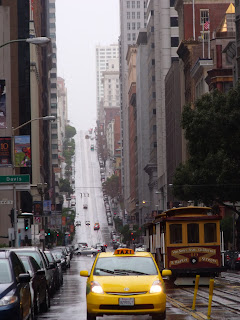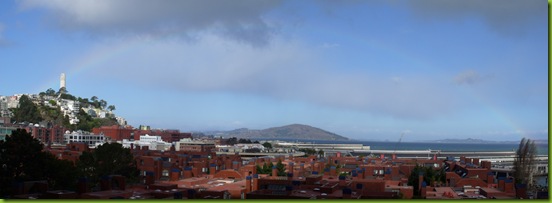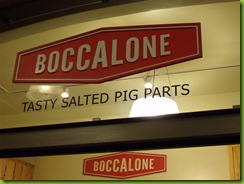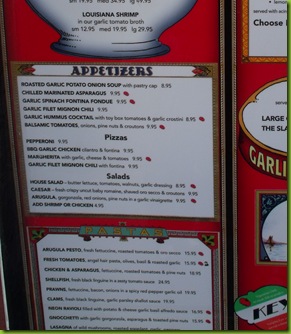I’m really not doing this to annoy my friend Jill, who’s trying to get her head around her exciting new web project about veganism (about which, more later) but I want to delve a little bit into the meat-eating culture of this region. Not farming or ranching, as such, because I know bugger-all about that here (except that we like it to rain every now and then to make the cows grow) but rather the way meat is eaten, the way it is cut and sold- things which differ hugely from place to place.
For example, during my time in Germany the trip to the butcher’s presented its own challenges. You tend to had to know in advance what you intended to buy, because the range of option open once you got inside was so phenomenal as to be off-putting. The stereotype of the sausage-eating German is no myth. There is variety and range when it comes to your choice of Wurst. No two butchers are alike. I even used to go to one butcher (on Diezer Strasse) for sausage and another near the Neumarkt for fresh meat. Fresh meat was its own range of pitfalls. In Germany, they will cut pieces of meat directly from the large cut, to order. You can’t go into a German butcher and tell from the shape of the piece of meat an appropriate method of cooking it. You have to Know What You Are Doing. It all looks pretty much the same, and to get, for example, a steak to grill, you have to know the appropriate term to avoid ending up with something best left in the crock-pot for eight hours.
Here in the western US, as in England, beef has a centuries-old place in the heart of the local culture. It stands for an industry which is more than just a livelihood- ranches are passed down from one generation to the next. Devotion to ranching is sometimes synonymous with devotion to your granddad. Beef has iconic cultural status. As one of my favourite bumper stickers puts it “The West wasn’t won on salad.” Well, as has been borne out by my experience in California for the past year and a bit, the Americans don’t make things any easier than the Germans do. Again, you have to know the appropriate vocabulary, which is made all the harder by the fact that the Americans use mostly the same words the Brits do to refer to pieces of raw cow, but they apply them to different cuts. Sneaky, eh?
They use the term flank, just as we do, but US flank steak is what we call skirt, whereas they refer to what we call flank as a part of the bottom of the round. Everything referred to as chuck steak in the UK would be called chuck in America, but the reverse is not true. The British term silverside refers to something which is often called rump roast here in America, which is nothing- nothing- to do with the UK’s rump steak. Well, not really. Possibly a bit. It’s right next door to it, anyway, but it’s not the same. Because what we Brits call rump is mainly covered by the American sirloin, tenderloin, top sirloin and bottom sirloin cuts. I think so, anyway. Are you confused yet? I am, and I was the one who brought it up in the first place. We all agree on brisket anyway. Except you braise it in England and you barbecue it here.
![1601653_690e54f3[1] 1601653_690e54f3[1]](http://lh4.ggpht.com/-kAoNZkqVHk8/UDaszR4sU1I/AAAAAAAAATQ/ORdVHOg_sqY/1601653_690e54f3%25255B1%25255D_thumb%25255B4%25255D.jpg?imgmax=800) By the way, these terms differ locally across America to a certain extent too. It’s no wonder that when I came over here and tried grilled tri-tip, the Central Coast’s gift to the food world, I had a hell of a time trying to get the butcher back home to reproduce the cut. It’s only in the past fifteen to twenty years that the cut has become known outside the Central Coast and the further eat you go, the less well-known it becomes. I would argue that Oliver and Eden, in the Grainger Market in Newcastle (see left), was one of the better butcher’s I used to shop at. So, knowing, as everyone with a barbecue between Ventura and Monterrey does, that tri-tip is from the bottom sirloin, I went to Oliver and Eden and confidently explained what I wanted. The butcher overcame his blank look as quickly as he could, and confidently explained that I was making, not to put too fine a point on it, no sense whatsoever. it took two return trips, with printed material and cow diagrams and incredible amounts of persistence an patience by the butcher, to get a tri-tip. It was worth it.
By the way, these terms differ locally across America to a certain extent too. It’s no wonder that when I came over here and tried grilled tri-tip, the Central Coast’s gift to the food world, I had a hell of a time trying to get the butcher back home to reproduce the cut. It’s only in the past fifteen to twenty years that the cut has become known outside the Central Coast and the further eat you go, the less well-known it becomes. I would argue that Oliver and Eden, in the Grainger Market in Newcastle (see left), was one of the better butcher’s I used to shop at. So, knowing, as everyone with a barbecue between Ventura and Monterrey does, that tri-tip is from the bottom sirloin, I went to Oliver and Eden and confidently explained what I wanted. The butcher overcame his blank look as quickly as he could, and confidently explained that I was making, not to put too fine a point on it, no sense whatsoever. it took two return trips, with printed material and cow diagrams and incredible amounts of persistence an patience by the butcher, to get a tri-tip. It was worth it.
The other things that every trainee pitmaster knows about tri-tip are that it was first popularised in Santa Maria, 30 miles south of San Luis Obispo, and that it is not traditionally barbecued in the traditional sense of slow-roasting at low temperatures over charcoal until it could be pulled apart with a spoon, but rather grilled over hot oak logs and then sliced. It’s standard fare at special occasions here, and as such it is sometimes neglected, taken for granted and inadvertently abused. That’s because the traditional recipe is its own worst enemy. The cut itself is not the tenderest. It is hard to grill such a large piece of meat (they are usually around 3-4lb) to the point where it’s cooked without burning the outside. You don’t slow cook it. The fibres don’t break down over hours of slow heating. The dry rub makes no use of acids or any tenderising agents. When we had tri-tip at our wedding, Chuck’s Barbecue did divert from the traditional procedure. Chuck is from Kansas City (which is in Missouri….don’t ask) which is one of the capital cities of barbecue cuisine. Smoking the beef for hours ensures its tenderness, and produced excellent results. It’s hard to grill tri-tip for 100 people without it ending up tough.
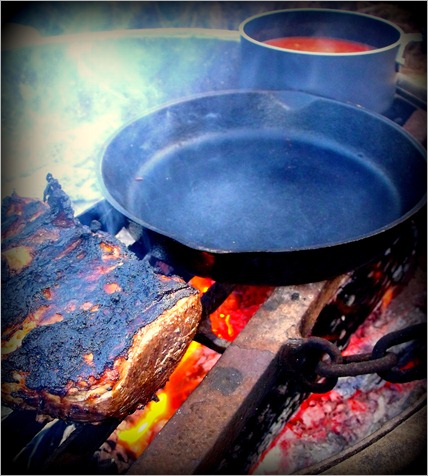
How about for four, though? I was going to Big Sur, camping with friends. There was a tri-tip in the freezer. We had oak logs for the campfire. It was far too tempting to resist. I used the traditionally minimalistic Santa Maria seasonings of garlic, black pepper and salt. This allows the flavour of the well-marbled beef to come through, without being buried in spices. Actually, I used garlic powder- fresh garlic would have burned in the intense heat from the fire and become bitter. I tossed the frozen meat with the seasoning in a Ziploc bag and allowed it to defrost slowly in the fridge for a couple of days, turning it every now and again.
I seared it over a hot oak campfire, taking the opportunity to take an artsy shot of it cooking alongside a cast iron pan (used to warm flour tortillas) and a pot of beans. Then, I wrapped it in foil to prevent the outside burning any further, and cooked it over the cooler part of the fire until the inside reached 135°F. I removed it from the grill and rested it in the foil until the temperature came up to 145°F. It was fantastic, served with grilled onions and peppers, beans and flour tortillas, tequila to wash it down.
This afternoon I’ll be cutting up 14lb of pork shoulder, and it will be a rare treat. Given the reverence with which beef is treated, it’s sometimes a little disheartening to see pork come such a poor second in shops. When I say this, I don’t mean that the cuts aren’t good or that the meat is poor quality; just the reverse. When pork is on offer, it seems only ever to be premium cuts- overwhelmingly pork loin. Pork loin is beautiful, lean white meat. And on its own it’s as dull as ditchwater. It needs to be smoked, or served with a sauce, or a ridiculous marinade. And then what you often get is dull meat, with a tasty marinade or sauce. It seems to be everywhere here. Where’s the pork belly? Well, actually, I know the answer to that one- it’s all been made into bacon. American bacon is wonderful stuff, but I almost resent the way all the pork belly ends up being cured and sliced. It could be rolled or sliced and roasted, with garlic and caraway or with Chinese spices.
I’m not entirely sure where the legs of these pigs go, either. It seems they all have loins and pre-bacon bellies, but no legs and precious few shoulders. You see loin chops, but no shoulder chops, or hand of pork. A disturbing amount of pork seems to come off-the-bone too. When I say “loin chops”, they are basically medallions of pork loin. It’s frankly bewildering, at times. It’s even more so with lamb. There seems to be almost no cut of lamb other than rack or leg. What the HELL do you put in your curries, California??? I think I’ve cracked the mystery as to why Americans serve braised salt beef, called corned beef here and almost unknown in Ireland, as a traditional Irish dish on St. Patrick’s day. It’s because if they tried to make Irish stew, they’d be confronted with the uncomfortable fact that you can’t buy shoulder or neck of lamb for love nor money, and no amount of Guinness could drown their sorrows.
I’m not entirely sure where the legs of these pigs go, either. It seems they all have loins and pre-bacon bellies, but no legs and precious few shoulders. You see loin chops, but no shoulder chops, or hand of pork. A disturbing amount of pork seems to come off-the-bone too. When I say “loin chops”, they are basically medallions of pork loin. It’s frankly bewildering, at times. It’s even more so with lamb. There seems to be almost no cut of lamb other than rack or leg. What the HELL do you put in your curries, California??? I think I’ve cracked the mystery as to why Americans serve braised salt beef, called corned beef here and almost unknown in Ireland, as a traditional Irish dish on St. Patrick’s day. It’s because if they tried to make Irish stew, they’d be confronted with the uncomfortable fact that you can’t buy shoulder or neck of lamb for love nor money, and no amount of Guinness could drown their sorrows.
It has been suggested to me that supermarkets serving the Hispanic community would have more variety, particularly in terms of the cuts of pork. I don’t know whether this is true or not but it seems to me that Mexican cuisine certainly knows how to deal with the less pretty cuts of pork. Carnitas, for example, done properly- not stewed or deep-fried. The fattiest part of the shoulder I’m cutting up will be cubed and simmered in orange juice. This simmering renders out the pork fat as the water in the juice evaporates, leaving it in its own fat. You then simmer it until a golden brown crust appears on the cubes of pork shoulder and use it to fill tacos, possibly with some salsa verde made from the increasingly monstrous tomatillo crop in our front garden. Proper food!



